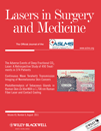Continuous wave terahertz transmission imaging of nonmelanoma skin cancers
Abstract
Background and Objective
Continuous wave terahertz imaging has the potential to offer a safe, noninvasive medical imaging modality for delineating human skin cancers. Terahertz pulse imaging (TPI) has already shown that there is contrast between basal cell carcinoma and normal skin. Continuous-wave imaging offers a simpler, lower cost alternative to TPI. The goal of this study was to investigate the feasibility of continuous wave terahertz imaging for delineating skin cancers by demonstrating contrast between cancerous and normal tissue in transmission mode.
Materials and Methods
Two CO2 optically pumped far-infrared molecular gas lasers were used for illuminating the tissue at two frequencies, 1.39 and 1.63 THz. The transmitted signals were detected using a liquid Helium cooled Silicon bolometer. Fresh skin cancer specimens were obtained from Mohs surgeries. The samples were processed and imaged within 24 hours after surgery. During the imaging experiment the samples were kept in pH-balanced saline to prevent tissue dehydration. At both THz frequencies two-dimensional THz transmission images of nonmelanoma skin cancers were acquired with spatial resolution of 0.39 mm at 1.4 THz and 0.49 mm at 1.6 THz. For evaluation purposes, hematoxylin and eosin (H&E) histology was processed from the imaged tissue.
Results
A total of 10 specimens were imaged and it was determined that for both frequencies, the areas of decreased transmission in the THz image correlated well with cancerous areas in the histopathology. Two negative controls were also imaged. The difference in transmission between normal and cancerous tissue was found to be approximately 60% at both frequencies, which suggests that contrast between normal and cancerous tissue at these frequencies is dominated by differences in water content.
Conclusions
Our results suggest that intraoperative delineation of nonmelanoma skin cancers using continuous-wave terahertz imaging is feasible. Lasers Surg. Med. 43:457–462, 2011. © 2011 Wiley-Liss, Inc.




